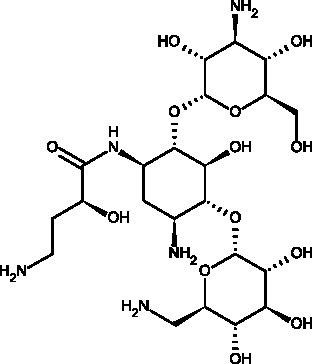Trade names Amikin, others MedlinePlus a682661 CAS ID 37517-28-5 | AHFS/Drugs.com Monograph Molar mass 585.603 g/mol | |
 | ||
Pregnancycategory AU: DUS: D (Evidence of risk) ATC code D06AX12 (WHO) J01GB06 (WHO), S01AA21 (WHO) | ||
Aminoglycosides gentamycin tobramycin amikacin
Amikacin is an antibiotic used for a number of bacterial infections. This includes joint infections, intraabdominal infections, meningitis, pneumonia, sepsis, and urinary tract infections. It is also used for the treatment of multidrug-resistant tuberculosis. It is used either by injection into a vein or muscle.
Contents
- Aminoglycosides gentamycin tobramycin amikacin
- Medical uses
- Bacterial susceptibility data
- Adverse effects
- Administration
- Resistance
- References
Common side effects include hearing loss, balance problems, and kidney problems. Other side effects include paralysis resulting in the inability to breathe. If used during pregnancy it may cause permanent deafness in the baby. Amikacin is in the aminoglycoside family of medications. It works by blocking the function of the bacteria's 30S ribosomal subunit, making it unable to make protein.
Amikacin was patented in 1971 and came into commercial use in 1976. It is on the World Health Organization's List of Essential Medicines, the most effective and safe medicines needed in a health system. The wholesale cost in the developing world is 13.80 to 130.50 USD for a month. In the United States a typical course of treatment costs 25 to 50 USD. It is made from kanamycin.
Medical uses
Amikacin is most often used for treating severe, hospital-acquired infections with multidrug-resistant Gram-negative bacteria such as Pseudomonas aeruginosa, Acinetobacter, and Enterobacter. Serratia marcescens and Providencia stuartii are also included in the spectrum. Amikacin can also be used to treat non-tubercular mycobacterial infections and tuberculosis (if caused by sensitive strains) when first-line drugs fail to control the infection.
Amikacin may be combined with a beta-lactam antibiotic for empiric therapy for people with neutropenia and fever.
Liposomal amikacin for inhalation is currently in late stage clinical trials for the treatment of respiratory diseases, such as cystic fibrosis, Pseudomonas aeruginosa, non-tubercular mycobacterial infections and bronchiectasis.
Bacterial susceptibility data
Amikacin is usually used as a last-resort medication against multidrug-resistant bacteria. The following represents susceptibility data on a few medically significant microorganisms.
Adverse effects
Side-effects of amikacin are similar to those of other aminoglycosides. Kidney damage and hearing loss are the most important effects. Because of this potential, blood levels of the drug and markers of kidney function (creatinine) may be monitored. Moreover, doses are adjusted specifically based upon serum Creatinine clearance in clinical settings.
Administration
Amikacin may be administered once or twice a day but must be given by the intravenous or intramuscular route or via nebulization. There is no oral form available as amikacin is not absorbed orally. In people with kidney failure, dosage must be adjusted according to the creatinine clearance, usually by reducing the dosing frequency.
Resistance
Amikacin evades attacks by most of the antibiotic-inactivating enzymes that are responsible for antibiotic resistance in bacteria. This is accomplished by the L-hydroxyaminobuteroyl amide (L-HABA) moiety attached to N-1 (compare to kanamycin), which inhibits acetylation, phosphorylation, and adenylation in the distant amino sugar ring (C-2,C-3,C-4). To prevent the development of bacterial resistance to this antibiotic, its use is tightly regulated.
